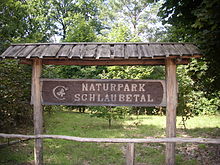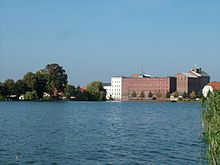Schlaubetal Nature Park
| Schlaubetal Nature Park | ||
|---|---|---|
|
|
||
| Location: | Brandenburg , Germany | |
| Next city: | Eisenhüttenstadt | |
| Surface: | 227 km² | |
| Founding: | December 27, 1995 | |
| Address: | Schlaubetal Nature Park Management, Wirchensee nature reserve 15898 Neuzelle, OT Treppeln |
|

The Schlaubetal Nature Park was founded on December 27, 1995 and is located southeast of Berlin in the state of Brandenburg . It extends from Müllrose in the north over the Reicherskreuzer Heide to Drewitz, a district of the Jänschwalde municipality , in the south and from Grunow-Dammendorf in the west via Henzendorf to Bomsdorf in the east.
Of its 227.8 km², 80.1 km² are in six landscape protection areas , 34.4 km² are nature reserves and 73.6 km² are fauna-flora-habitat areas (FFH).
nature
The landscape was essentially created around 20,000 years ago in the Brandenburg stage of the Vistula Ice Age . This created the meltwater systems of the Schlaube , Dorche , Oelse and Demnitz .
In this area there are completely different landscapes in a very small space. Extensive pine forests as well as beech and sessile oak forests , alder quarries , deep gorges in which the rivers flow very quickly, but also calm lakes or wet meadows .
The pine forests show a long tradition of forest use, such as the Mahlheide with farm pines , ancient trees with widely spreading branches ( pine bushes ), but also modern plantings. The Reicherskreuzer Heide is an extensive heathland area with birch forests .
Over 140 rare bird species live in the Schlaubetal Nature Park, including ospreys and sea eagles , kingfisher and black stork . Numerous species of fish live in the lakes, as the mills' lakes have also been used for fish farming over the centuries. There are numerous amphibian species that find their spawning grounds here. Almost three quarters of the large butterfly species recorded in Brandenburg , such as the raised bog mother-of-pearl butterfly , a rich population of game , but also otters and several bat species .
1,000 plant species have been identified, 13 of which are currently still orchids , such as lady's slipper and coral root . 13 animal and plant species can only be found in the Schlaubetal Nature Park throughout Brandenburg.
At Henzendorf there is a boulder park on about 4 hectares. 126 colored and hewn stones, the heaviest of which weighs 30 tons, the oldest is around 1.8 million years old, are evidence of the earth's history. The places of origin show how they took the route with the glacier into the Schlaubetal.
Nature reserves
- The Schlaubetal , 130 hectares, were already under protection in 1961. Due to its extraordinary biodiversity and the large number of bodies of water, it is the central part of the nature park. In 2002 the area was expanded again, today it covers 1,502.8 hectares.
- The Fünfeichen primeval forest has also been a protected area since 1961. 10.84 hectares of total reserve show the forest as it is designed without human intervention.
- The near-natural silting bogs around the Teufelssee have been protected on an area of 56.8 hectares since 1961.
- Tauer oaks and Pinnower Läuche , this protected area already existed in 1967 with the Tauer oaks on 23.68 hectares, in 2002 it was expanded to 1,544.6 hectares, the sessile oaks are now in the total reserve.
- In 1981 the moored river valley of the Demnitz followed, the upper Demnitz valley is 87.5 ha .
- The Mahlheide has been protected on 33.4 hectares with its unusual pine trees since 1990 .
- Clear water lakes with bog formation form the Große Göhlenze and Fichtengrund , also in 1990 the 268 hectares were placed under protection.
- With the closure of the Lieberose military training area , the Reicherskreuzer Heide and Schwansee can again contribute to groundwater formation . Since 1995, 2814 hectares of heathland have been under protection.
- The moor forests of the Trautzke lakes and moors have also been part of the Schlaubetal since 2002, they cover an area of 68.4 hectares.
- In 2003, 361.4 hectares of the northern section of the valley were placed under protection as the Lower Schlaubetal . Waters and wetlands also dominate here .
- The Pastlingsee , a natural eutrophic lake, was protected with 61.3 hectares in 2003, but is in critical condition.
- The Calpenzmoor followed , 136 hectares became a protected area in 2004, as there are a. former peat cuttings are located.
- Klautzkesee and Waldmoore with Kobbelke were also placed under protection in 2004 with a total area of 383 ha.
Landscape protection areas
- The Schlaubetal with 6,415.91 ha has been designated since 1965, including the ponds of the Kieselwitzer Mühle.
- The Dorchetal and the pheasant forest near Neuzelle with 627.1 hectares have been protected areas since 1965.
- The Göhlensee was created in 1968 with 45 hectares of landscape protection area .
- The Pinnower See ,
- the big lake
- and the Pastling Lake with 69.62 hectares have also been protected since 1968.
Buildings
There were 17 mills in the nature park that once used the waters. A dense network of hiking trails and nature trails leads to the 11 preserved ones. These mills used the water on natural slopes and artificially dammed bodies of water to grind grain and later also as hammer or saw mills .
Schlaube
- The oldest mill is the Müllroser Mühle , it was already in operation in 1275 and is the only one that is still there today.
- Built in the 12th century by the brothers of the Order of St. John in Friedland an der Schlaube, it was named Ragower Mühle when it was acquired by Gut Ragow in the 14th century . The Ragower mill stands today with preserved mill technology from 1920 as a museum under preservation .
- The Schernsdorfer Mühle , built in 1420 , later called Mittelmühle , can only be found as the remains of the foundation after its demolition at the end of the 1970s. There are remains of the mill dike and the supply channel.
- The mill in Kupferhammer received a copper hammer mill in 1553 and was widely known only as the copper hammer. Today a restaurant and the damming of the Schlaube reminds of their former location.
- The Bremsdorfer mill was built from half-timbered houses in the 16th century . Used for a long time as a grinding mill, fulling cloth and cutting mill, until it was shut down in 1958, energy was generated by means of a turbine . It still has a functioning mill wheel and is operated as a restaurant.
- The Kieselwitz mill was in operation from 1420 to 1930, when it was converted into a restaurant. Since it was closed in 1958, only the mill pond with the attached trout rearing ponds and a waterfall remind of them.
- The Schlaubemühle was mentioned in a document as early as 1420 as the dy mole zu Werchenow am Wirchensee . Operated as a restaurant until the 1970s, it was nationalized, and in 1993 the BUND Nature Conservation Information Center and a replica millwheel were built on the site .
Dorche
- From the Neuzeller Klostermühle , later known as the Royal Prussian Monastery Mill , already known in 1557, only small remnants of the technology can be seen in the cellar today, although it was only shut down in the 1960s. Until it was shut down, it was used to generate electricity, pond and ditch systems still exist.
- The Schlaben mill was first mentioned in 1350. As Belgers Mühle, the grain mill was used for the production of rye flour until 1954 and for fodder meal until the early 1960s. Since the interior furnishings from 1924/26 are still completely preserved, it is a listed building. Today, however, the mill building is in a very dilapidated state.
- The largest mill in the Dorchetal was the Kummeroer Mühle . Donated to Neuzelle Abbey in 1293 , the mill worked as a flour, oil and tamper mill from 1700 until it was closed in 1930.
- A grinding mill, the Neumühle, was built by the Neuzelle monastery in 1650 . It was used as a cutting mill from 1688 until it was closed in 1950.
- The Mittelmühle was built near the Schwerzkoer Mühle in the 16th century . It was operated as an inn before the First World War , and a weaving mill was located on the premises until 1958 after the Second World War . After that it was converted into a holiday home and closed like at the turn of the century .
- The Schwerzko mill was mentioned in a document as early as 1420 . The former grinding and cutting mill , whose water wheel is 3.20 meters high and 1.50 meters wide, houses a mill shop and a restaurant in its listed premises. There are demonstrations of the saw frame .
Oelse
- The Oelsener Mühle , located on the former customs route, has been known since 1406 . From 1665 to 1954 it was a grinding mill in which oil seeds were also ground. The saw frame has been in operation again since 1990.
- In 1620 a cutting mill was built, which was converted into an oil and groats mill in 1758 . From 1831 Walkmühle established what its name Walke mill was, then again to 1957 flour-milling, their demolition came around 1975. In is a new building site.
- The Jankemühle was built around 1600 as a grinding mill . From 1675 as a cutting mill, it was in operation until the First World War. After that they had in the summer boarders . With the admission of refugees in World War II, it was increased, in 1955 it burned down. The remaining buildings have been used by the forest administration since then.
- Matheus Klingemüller had his mill built around 1610. The Klingemühle was used as a farm 200 years later, and from 1970 as a holiday home. Today only a replica mill wheel reminds of them.
See also
Web links
- Brandenburg State Environment Agency (Nature Park Administration): Schlaubetal Nature Park
- Tourism offers in the nature park
literature
- Gudrun Hänschen: Take a look around here! Hikes along the Schlaube, Schlaubetal-Druck Kühl, May 2008, ISBN 3-941085-70-0
- Gudrun Hänschen: People leave - stories stay. Discoveries in the headwaters of the Schlaube, Schlaubetal-Druck Kühl May 2007, ISBN 3-9810282-7-9
- Sieghard Lang: The craft boy and the mermaid: The most beautiful legends about the Schlaubetal, Schlaubetal-Druck Kühl 1993, ISBN 3-9803519-0-4
- Hans J. Schulze: Neuzelle - Schlaubetal and the surrounding area, publisher: Klosterbrauerei Neuzelle GmbH, September 2000, ISBN 3-00-006490-7
- Heinz Tölle: The mills in the Schlaubetal. Your story from the Middle Ages to the present. Digital printing and publishing, Bielefeld 1998, ISBN 3-9805548-4-8
Individual evidence
- ↑ Jana Pozar: The silent death of the Pastlingsee. In: Lausitzer Rundschau from June 19, 2015, accessed on July 7, 2015
- ↑ Nature reserves in Brandenburg ( page no longer available , search in web archives ) Info: The link was automatically marked as defective. Please check the link according to the instructions and then remove this notice. (PDF file; 162 kB), Ministry for the Environment, Health and Consumer Protection, as of January 2010
- ↑ Brandenburg rules System (BRAVORS) Regulation on the nature reserve "Klautzkesee and forest Moore with Kobbelke" of 5 March 2002, (GVBl.II / 02, [no. 12], p 242)
- ^ Ministry for Rural Development, Environment and Agriculture of the State of Brandenburg (Ed.): List of Landscape Protection Areas in Brandenburg , December 2013, accessed on February 15, 2016.
- ↑ GenWiki: Schlabener Mühle / Mühle Belger





